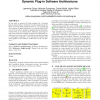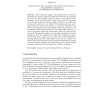189 search results - page 26 / 38 » The unfolding of general Petri nets |
TAGT
1998
Springer
14 years 28 days ago
1998
Springer
Reactive systems perform their tasks through interaction with their users or with other systems (as parts of a bigger system). An essential requirement for modeling such systems is...
CMG
2003
13 years 10 months ago
2003
The queueing Petri net (QPN) paradigm provides a number of benefits over conventional modeling paradigms such as queueing networks and generalized stochastic Petri nets. Using qu...
ENTCS
2007
13 years 8 months ago
2007
The first and the second author introduced reversible ccs (rccs) in order to model concurrent computations where certain actions are allowed to be reversed. Here we t the core of...
ATAL
2005
Springer
14 years 2 months ago
2005
Springer
In this work we present the basic concepts for a dynamic plug-in-based software architecture using concepts from the Petri net-based MAS framework Mulan. By transferring the conce...
ISTA
2008
13 years 10 months ago
2008
This contribution suggests a novel approach for a systematic generation of a process model in an informal environment. It is based on the claim that the knowledge about the process...


